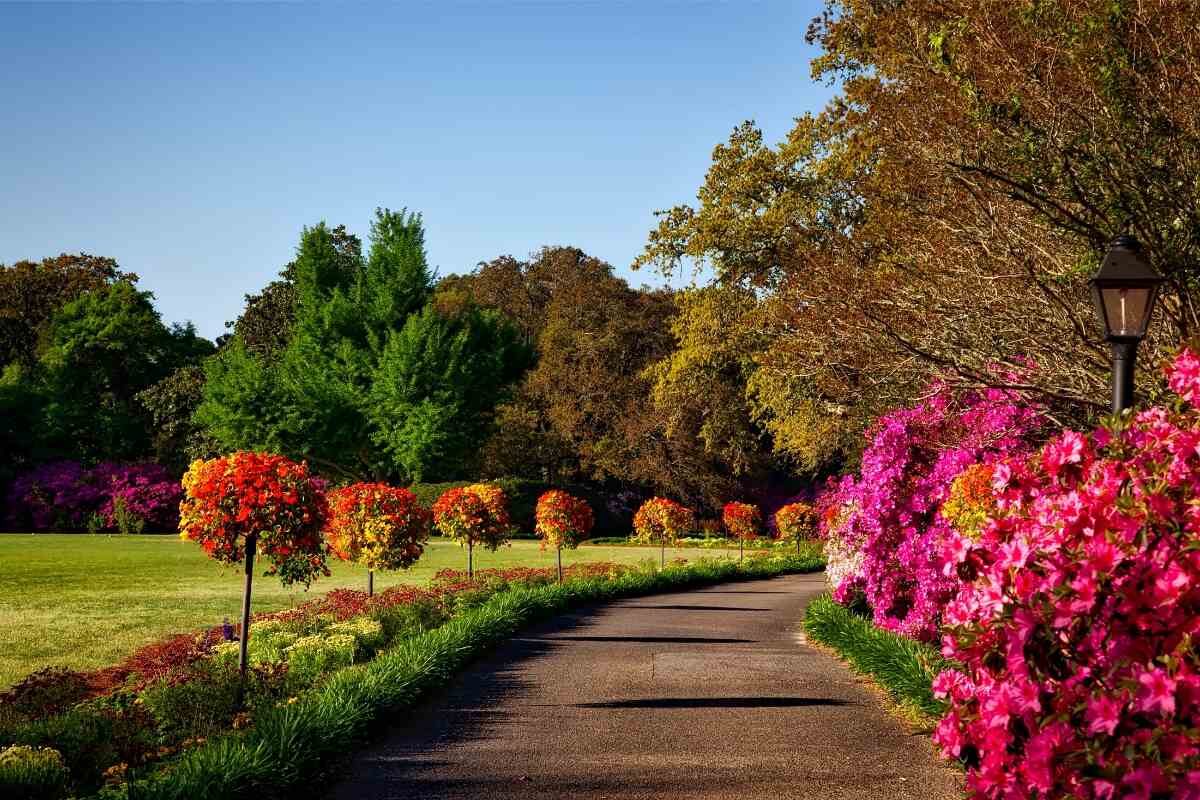
Alabama’s wonderful climate and location make it perfect for all kinds of gardening and outdoor activities. Situated in the extreme Southeast, Alabama falls into hardiness zones 7a through 9a on the USDA Plant Hardiness Zone Map. That means the most extreme yearly cold temperature is as low as 0° to 5° F in some areas and as high as 20 to 25 degrees in others.
What does this mean for you? Essentially, it means you must select plants that can survive these low temperatures.
From the rolling hills of North Alabama to the lush Gulf Coast, each region in the Heart of Dixie offers its own special gardening challenges. Let’s take a look at how the weather conditions and plant hardiness zones vary across the state so you can choose the best plants for your landscape.
On this page:
- North Alabama USDA Hardiness Zone
- Central Alabama USDA Hardiness Zone
- South Alabama USDA Hardiness Zone
- Why Alabama Planting Zones Matter
- FAQ
North Alabama USDA Hardiness Zone
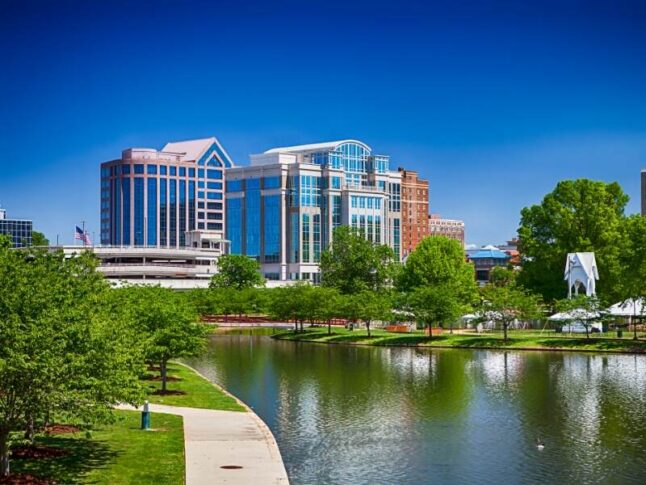
From Tennessee all the way down to Birmingham is an area of rolling hills and valleys. It’s often called the Tennessee Valley because of its position by the Tennessee River. This area of North Alabama’s USDA Plant Hardiness Zone is 7a to 7b, so you must choose plants that can survive potential low temperatures of 0° to 10° F.
Even though temperatures can dip way down, winters in North Alabama are usually mild, with average highs around 49°F and lows near 33°F. Summers bring warmth and humidity with highs near 90°F and lows around 70°F. The region gets around 56 inches of rainfall each year, a little less than South Alabama.
Gardeners in North Alabama get a pretty long growing season. The first frost of the year usually arrives between mid-October and the end of the month, while the last frost is likely to occur between April 1st and 15th. So, all in all, homeowners here get around 200 days to enjoy their lawns and gardens.
Here’s a quick rundown of the specific hardiness zones of several North Alabama cities:
| City | USDA Plant Hardiness Zone | Minimum Winter Temperature |
| Florence | 7a | 0 – 5 °F |
| Huntsville | 7a – 7b | 0 – 10 °F |
| Decatur | 7b | 5 – 10 °F |
| Scottsboro | 7b | 5 – 10 °F |
| Albertville | 7b | 5 – 10 °F |
| Fort Payne | 7a – 7b | 0 – 10 °F |
The Right Plants to Grow in North Alabama
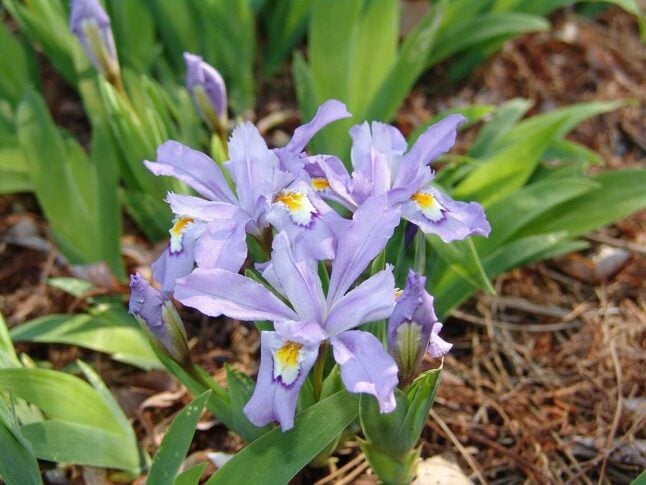
Since North Alabama has an amazing growing season, gardeners can really take advantage of it with a huge selection of annuals, perennials, trees, and shrubs. Beautiful native Alabama plants that thrive in the area are plentiful and don’t require much care. As if the locals weren’t spoiled enough, many non-native species love the climate here, too.
North Alabama has some amazing native plants for your garden. Gorgeous wildflowers like fire pink and eastern Columbine will give your yard some color and life. Plus, trees such as dogwoods, maples, oaks, and magnolias will give it that extra lushness.
Native plants for North Alabama:
- Fire Pink (Silene virginica)
- Coneflowers (Echinacea spp.)
- Dwarf Crested Iris (Iris cristata)
- False Indigo (Baptisia australis)
- Eastern Columbine (Aquilegia canadensis)
- Birds-foot Violet (Viola pedata)
- Bignonia capreolata (Crossvine)
- Dogwoods (Cornus spp.)
- Red Maple (Acer rubrum)
- Oakleaf Hydrangea (Hydrangea quercifolia)
- Southern Magnolia (Magnolia grandiflora)
- Carolina Plum (Prunus caroliniana)
- Alabama snow wreath (Neviusia alabamensis)
Other plants that aren’t native can still thrive in the area. Think hydrangeas and lavender, bamboo and Mazari palms for a tropical feel, and annuals like marigolds and petunias. Your garden will be a sight to behold.
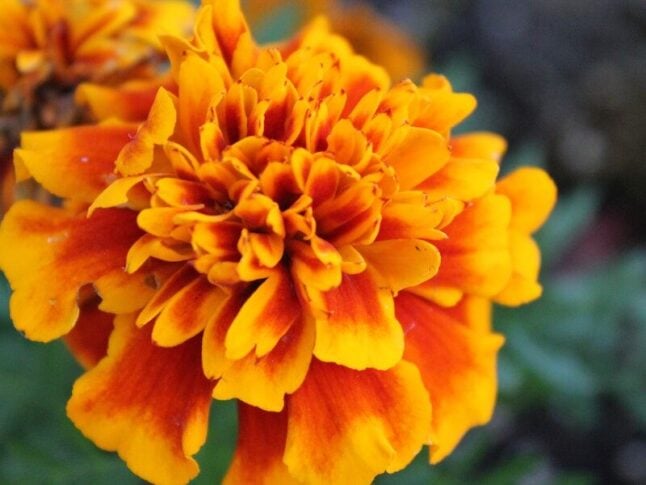
Exotic plants for North Alabama:
- Marigolds (Tagetes)
- Foxglove (Digitalis purpurea)
- Hortensia (Hydrangea)
- Lavender (Lavandula)
- Weaver’s Bamboo (Bambusa textilis)
- Mazari palm (Nannorrhops ritchiana)
- Petunia (Petunia Juss.)
- Shasta Daisy (Leucanthemum maximum)
Best Grass for North Alabama
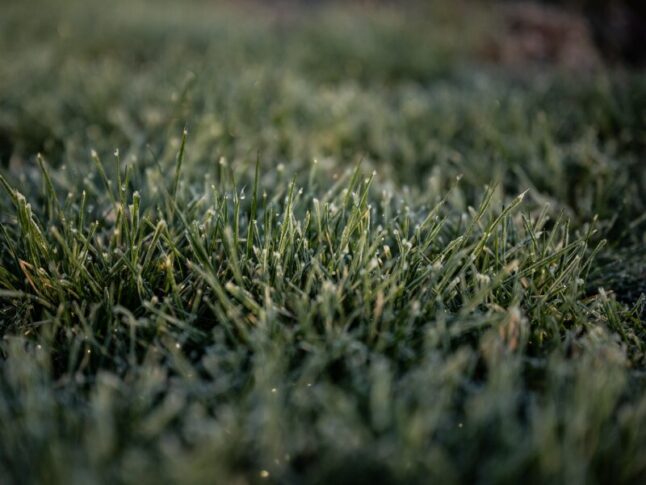
Don’t forget about the right type of grass seed. North Alabama is mostly home to warm-season grasses, but a few cool-season varieties are around, too. The best grass seeds for the area include:
- Bermudagrass
- Zoysiagrass
- Perennial Ryegrass
- Kentucky Bluegrass
- Tall Fescue
- Bahiagrass
Learn more in our guide to the best grass seed for Alabama.
Central Alabama USDA Hardiness Zone
![Mont]germy Alabama State capitol Building](https://www.lawnstarter.com/blog/wp-content/uploads/2023/06/montgomery-state-capitol-building-alabama-646x485.jpg)
Central Alabama is the stretch of land between Birmingham and Montgomery. This is an area of slightly warmer weather, providing a hospitable environment for gardening. Central Alabama falls into USDA Hardiness Zone 7b to Zone 8b, which are ideal for warm-season grasses.
Central Alabama boasts mild winters with typical lows around 33°F and highs ranging up to 48°F. In the summer, you can expect to feel the heat, with temperatures soaring into the high 90s and lows in the 70s. On average, the region receives 58 inches of rain annually, although the southern part of Central Alabama tends to get more precipitation than the northern end.
Folks who love to garden are in luck because Central Alabama has a long growing season from mid-March until mid-November. The average first frost arrives at the end of November, and the last one approximately mid-February. That gives gardeners about 265 days of optimal growing conditions.
See the specific hardiness zones of Central Alabama’s major cities below:
| City | USDA Plant Hardiness Zone | Minimum Winter Temperature |
| Cullman | 7b | 5 – 10°F |
| Jasper | 7b | 5 – 10°F |
| Anniston | 7b – 8a | 5 – 15°F |
| Birmingham | 7b – 8a | 5 – 15°F |
| Bessemer | 7b – 8a | 5 – 15°F |
| Gadsden | 7b – 8a | 5 – 15°F |
| Auburn | 8a | 10 – 15°F |
| Calera | 8a | 10 – 15°F |
| Tuscaloosa | 8a | 10 – 15°F |
| Valley | 8a | 10 – 15°F |
| Montgomery | 8a – 8b | 15 – 20°F |
The Right Plants to Grow in Central Alabama

Central Alabama’s got the kind of climate that just begs you to plant something. Since it’s located in hardiness zones 7b to 8b, you can really get creative. Depending on your preferences, you could cultivate a garden full of native flora or embrace a fusion of homegrown and imported plants.
The local wildlife will be thankful if you choose some native species to sprinkle in since they offer a much-needed food source.
You can start with Central Alabama native plants such as:
- Oakleaf Hydrangea (Hydrangea quercifolia W. Bartram)
- Wavyleaf Purple Coneflower (Echinacea simulate)
- Largeflower Tickseed (Coreopsis grandiflora var. grandiflora)
- American bluehearts (Buchnera americana)
- Carolina Allspice (Calycanthus floridus)
- Mountain Witch Alder (Fothergilla major)
- Shrubby St. John’s Wort (Hypericum prolificum)
For something a little more distinct, you could also consider exotic trees, shrubs, and flowers like:
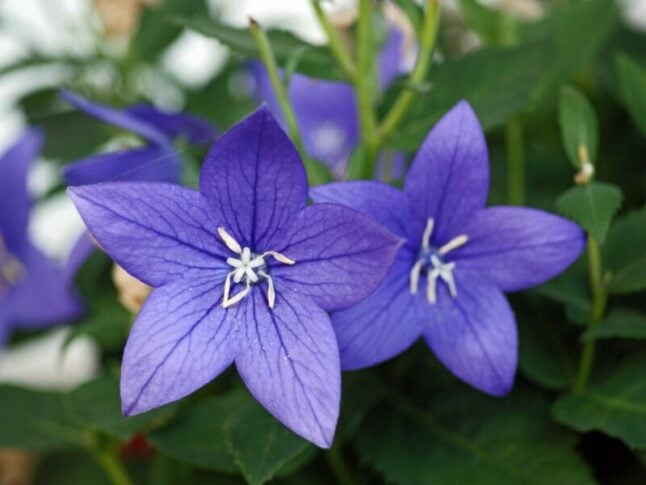
- Camellias (Camellia spp.)
- Hosta (Hosta spp.)
- Oleanders (Nerium oleander)
- Wax myrtles (Myrica)
- Winter honeysuckles (Lonicera fragrantissima)
- Balloon Flower (Platycodon grandiflorus)
- Canna Lily (Canna x generalis)
- Daylily (Hemerocallis x hybrida)
- New England Asters (Symphyotrichum novae-angilae)
Raised garden beds are also a wise choice for Central Alabama, as they help ensure adequate drainage and protection against flooding during wet weather.
Best Grass for Central Alabama
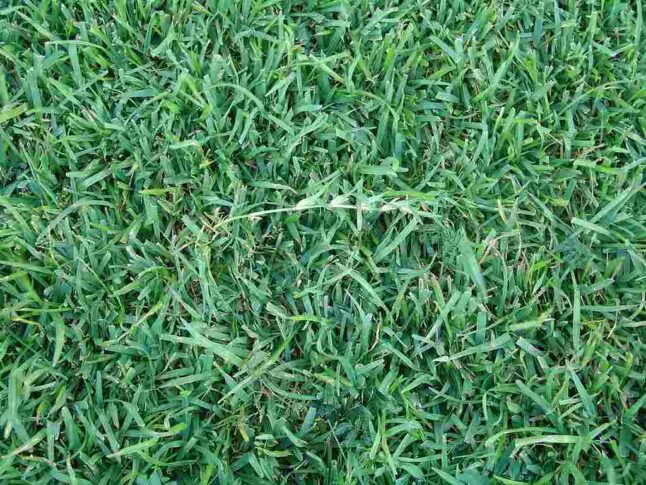
Central Alabama’s humid environment is perfect for warm-season grasses such as Bermudagrass, Zoysiagrass, and centipedegrass.
Moving northward, however, the mountain regions may also benefit from cool-season grasses like tall fescue and perennial ryegrass, which are especially fitting for over-seeding and winter-time protection. To determine which grass is best for you, see our guide to the best grass seed for Alabama.
South Alabama USDA Hardiness Zone
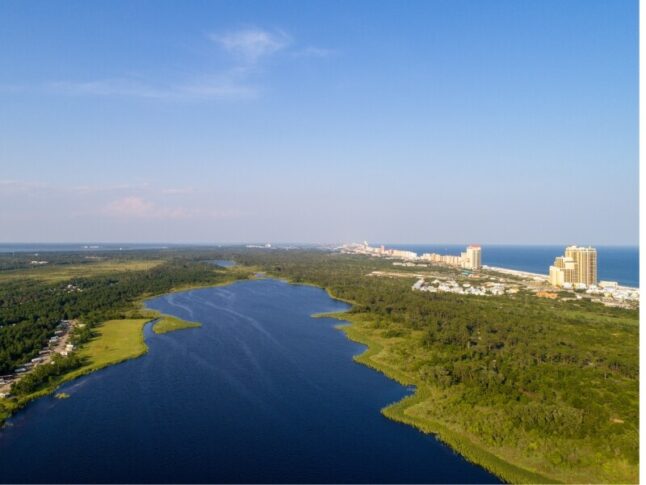
Further south, you’ll find yourself in the land of lower Alabama. There’s no specific boundary line that divides Central and South Alabama, but the southern portion of the state is typically considered to start in Montgomery and end in Mobile and Baldwin counties.
South Alabama’s USDA Plant Hardiness Zones range from Zone 8a in its northern parts to Zone 9a in its southern reaches. Just like any other southern location, things really heat up in the summer and remain relatively mild in the winter. Expect temperatures to dip to around 39°F in the cold months and spike to 92°F during summer.
The whole region between central and lower Alabama is known as the Black Belt because of its amazingly fertile soil that’s perfect for growing all sorts of plants and crops.
Due to South Alabama’s nearness to the Gulf of Mexico, heavy storms (even hurricanes and tornadoes!) may pass through the area during the summer months, especially near coastal towns. Annual rainfall usually averages about 65 inches, so it’s essential to choose plants that can handle a little flooding.
See the hardiness zones of specific South Alabama cities below:
| City | USDA Plant Hardiness Zone | Minimum Winter Temperature |
| Autaugaville | 8a | 15 – 20°F |
| Columbia | 8a | 15 – 20°F |
| Selmont-West Selmont | 8a | 15 – 20°F |
| Andalusia | 8a | 15 – 20°F |
| Eufaula | 8a – 8b | 15 – 25°F |
| Hartford | 8a – 8b | 15 – 25°F |
| Greenville | 8a – 8b | 15 – 25°F |
| Elba | 8a – 8b | 15 – 25°F |
| Foley | 8b – 9a | 20 – 30°F |
| Mobile | 8b – 9a | 20 – 30°F |
Because of the warmer weather, South Alabama has an extended growing season compared to the rest of the state. Mobile, for instance, can expect its first frost anywhere between late November and early December, while its last frost date is around the end of February. This provides South Alabama gardeners with some extra time to enjoy their plants.
Word of Caution: When planting in South Alabama, be aware of the potential risks involved. For example, avoid placing plants in low-lying areas that experience flood during heavy rains, as excessive waterlogging can devastate many plants.
The Right Plants to Grow in South Alabama
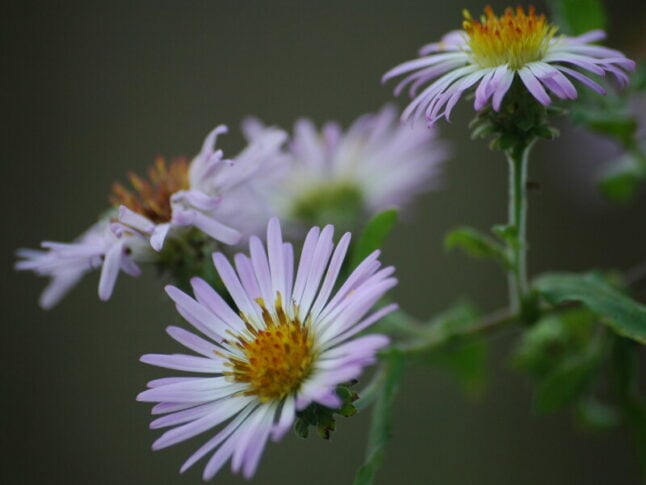
South Alabama’s heat and humidity can be a bit challenging for plants, which is why it’s a good idea to look into local natives first before committing to other varieties. These species will likely fare much better in the area’s climate and soil. Adding a few of these to your garden will surely bring your space to life.
Among the top native plants for South Alabama gardens are:
- Climbing Aster (Ampelaster carolinianus)
- Swamp Mallow (Hibiscus coccineus)
- Beautyberry (Callicarpa americana)
- Gulf Coast Penstemon (Penstemon tenuis)
- Oakleaf Hydrangea (Hydrangea quercifolia)
- Dogwoods (Cornus spp.)
- Southern Magnolia (Magnolia grandiflora)
- Gulf Coast Muhly Grass (Muhlenbergia capillaries)
- Yucca (Yucca filamentosa)
When choosing non-native plants for South Alabama, it is best to select specimens that are well-suited to the climate and soil. Some of the most popular ones here are:
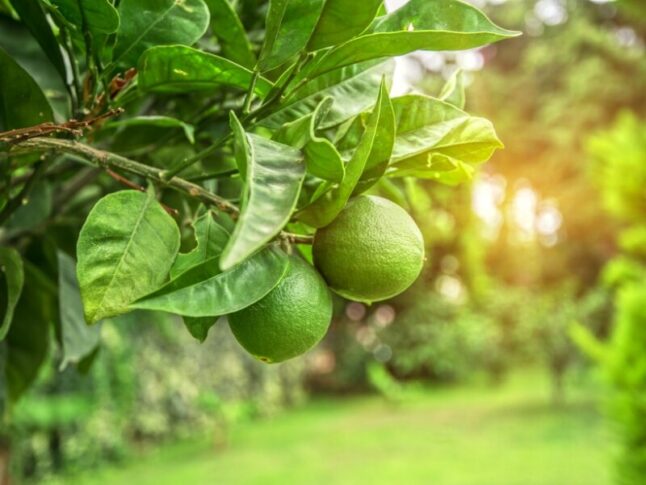
- Foxglove (Digitalis purpurea)
- Camellias (Camellia spp.)
- Virginia Iris (Iris virginica)
- Yarrow (Achillea spp.)
- Olives – e.g. Frantoio Olive Tree (Olea europaea ‘Frantoio’)
- Fruit trees – e.g. Fig tree (Ficus carica); Lime tree (Citrus aurantiifolia); Orange tree (Citrus sinensis)
Plus, herbs such as rosemary, oregano, and lavender are very easy to grow in this region. Soil conditions vary significantly, from loamy and sandy to heavy clay. It’s best to test the soil first to decide which plants are best for your particular site.
Usually, adding lime, fertilizer, mulch, and other organic soil amendments can help lighten heavier soils while providing nutrients for all of your non-native plants. For instance, you might consider adding quarter-inch gravel or perlite to aerate densely packed clay soils.
Best Grass for South Alabama
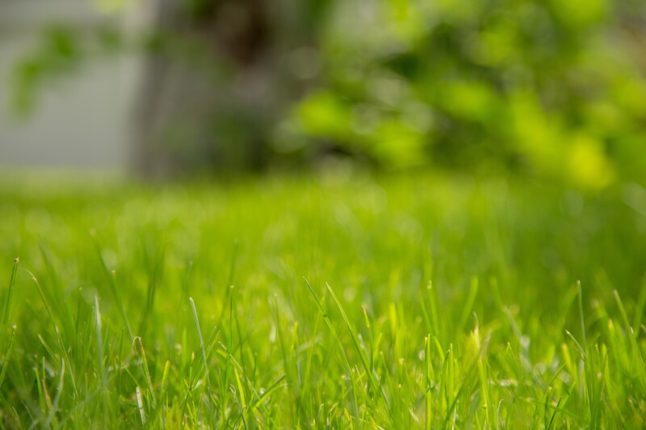
For South Alabama, warm-season grasses are a must. Bermudagrass, Zoysiagrass, Bahiagrass, and centipedegrass are all solid choices. But if you want something that can go the extra mile in terms of heat and drought resistance, St Augustinegrass is your guy.
Learn more about these warm-season grass types in our guide to the best grass seed for Alabama.
Just make sure you give your lawn a substantial watering during dry spells and stick to the proper lawn care schedule for Alabama, which includes specific times for fertilizing and mowing.
Why Alabama Planting Zones Matter
You can’t just pick any plant to put in your garden and expect it to flourish in Alabama. Knowing what growing zone you live in and selecting plants that can survive the local climate is essential. But don’t worry – once you get the hang of it, gardening and planting in Alabama will be a piece of cake!
Alabama’s planting zone spans from 7a to 9a, and you can easily figure out what zone you’re in with the USDA Plant Hardiness Zone Map. It’s based on 2012 USDA data and provides very accurate information. Just remember: Never pick a plant that’s rated outside of your zone.
Alabama’s Climate
You thought you knew what to expect from an Alabama summer. But with its humid subtropical climate, you’ll almost always be wondering what’s coming next. Average temperatures here are around 64°F – but the blistering heat of summer can reach up to 95°F. And don’t forget the Gulf of Mexico in the south – that area is especially prone to tropical storms.
On the flip side, Alabama winters are usually mild. The Appalachian Mountains to the northeast help buffer the cold temperatures. But, like many other Southerners, you’ll need to prepare for tornadoes. The season can be unpredictable in some regions, so always err on the side of caution and choose hardy plants for your landscape.
FAQ
What plant hardiness zone is Birmingham, AL?
Birmingham is located in Hardiness Zones 7b and 8a, where the minimum winter temperature ranges from 5 to 15°F.
Is Alabama in Zone 9?
Yes, some areas in Baldwin County, such as Foley, are located in Zone 9a – with a minimum winter temperature of 20-30°F.
What gardening zone is Huntsville, Alabama?
Huntsville in Madison County is located in Hardiness Zones 7a and 7b, which means the lowest winter temperatures are 0 to 10°F.
Is Alabama in the same planting zone as Florida?
While Alabama and Florida are geographically close, they don’t have the same planting zones, although there is some overlap between southern Alabama and northern Florida. Florida typically falls into higher zones, ranging from 8a to 10b, while Alabama is located in Zone 7a through 9a.
Are there a lot of weeds in Alabama?
Alabama’s great climate for gardening means your landscape plants aren’t the only ones that thrive here – there are also a ton of weeds that can flourish in your lawn and garden. Some of the most common Alabama weeds to look out for include:
- Nutgrass
- White clover
- Chickweed
- Annual bluegrass
- Dandelions
- Crabgrass
- Bindweed
- Musk thistle
- Buckhorn plantain
- Common purslane
Final Thoughts
Alabama has a great climate that provides plenty of opportunities for gardeners. From North Alabama’s rolling hills to the warmth of South Alabama, there’s something for everyone. Just select plants that can easily handle Alabama’s daily climate changes, and you’ve got a guaranteed beautiful garden.
Thankfully, the Interactive Planting Zone Map can help you determine your zone, so you can get the perfect picks to make your yard shine. If you’re still unsure which plants will work in your area, don’t fret – just reach out to a local landscaping pro in Alabama. An expert will be able to give you helpful tips and tricks on which plants grow best where you are. Whether you’re in Birmingham, Mobile, Huntsville, or Montgomery, you can count on professional advice to ensure your garden looks vibrant year-round.
Main Photo Credit: 12019 from Pixabay / Canva Pro / License